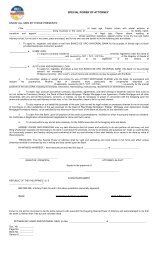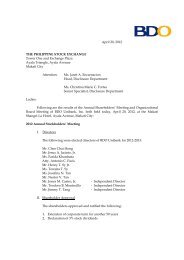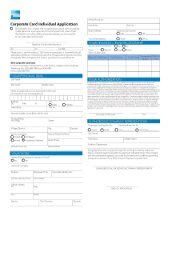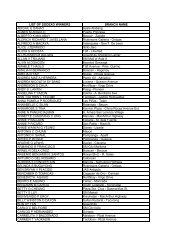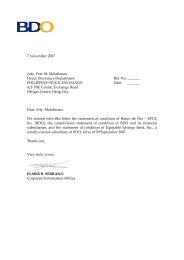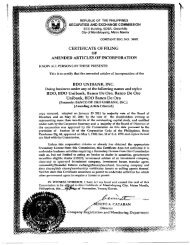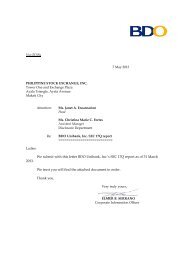Notes to Financial Statements - BDO
Notes to Financial Statements - BDO
Notes to Financial Statements - BDO
You also want an ePaper? Increase the reach of your titles
YUMPU automatically turns print PDFs into web optimized ePapers that Google loves.
<strong>Notes</strong> <strong>to</strong> <strong>Financial</strong> <strong>Statements</strong>DECEMBER 31, 2008, 2007 AND 2006(Amounts in Millions Except Per Share Data)- Change in the definition of return of plan assets <strong>to</strong> require the deduction of plan administration costs in the calculationof plan assets return only <strong>to</strong> the extent that such costs have been excluded from measurement of the defined benefi<strong>to</strong>bligation.- Distinction between short-term and long-term employee benefits will be based on whether benefits are due <strong>to</strong> be settledwithin or after 12 months of employee service being rendered.- Removal of the reference <strong>to</strong> recognition in relation <strong>to</strong> contingent liabilities in order <strong>to</strong> be consistent with PAS 37, Provisions,Contingent Liabilities and Contingent Assets, which requires contingent liabilities <strong>to</strong> be disclosed and not recognized.The Group will apply this amendment <strong>to</strong> PAS 19 on its 2009 financial statements.• PAS 38 (Amendment), Intangible Assets. The amendment clarifies when <strong>to</strong> recognize a prepayment asset, including advertisingor promotional expenditures. In the case of supply of goods, the entity recognizes such expenditure as an expense whenit has a right <strong>to</strong> access the goods. For services, an expense is recognized on receiving the service. Also, prepayment mayonly be recognized in the event that payment has been made in advance of obtaining right of access <strong>to</strong> goods or receipt ofservices. The Group initially determined that adoption of this amendment will not have a material effect on its 2009 financialstatements.• PAS 39 (Amendment), <strong>Financial</strong> Instruments: Recognition and Measurement. The definition of financial asset or financialliability at fair value through profit or loss as it relates <strong>to</strong> items that are held for trading was changed. A financial asset orliability that is part of a portfolio of financial instruments managed <strong>to</strong>gether with evidence of an actual recent pattern ofshort-term profit taking is included in such a portfolio on initial recognition. The Group initially determined that adoption ofthis amendment will not have a material effect on its 2009 financial statements.• PAS 40 (Amendment), Investment Property. PAS 40 is amended <strong>to</strong> include property under construction or development forfuture use as investment property in its definition of investment property. This results in such property being within the scopeof PAS 40; previously, it was within the scope of PAS 16. Also, if an entity’s policy is <strong>to</strong> measure investment property at fairvalue, but during construction or development of an investment property the entity is unable <strong>to</strong> reliably measure its fair value,then the entity would be permitted <strong>to</strong> measure the investment property at cost until construction or development is complete.At such time, the entity would be able <strong>to</strong> measure the investment property at fair value.Minor amendments are made <strong>to</strong> several other standards; however, those amendments are not expected <strong>to</strong> have a material impac<strong>to</strong>n the Group’s financial statements.2.3 Basis of ConsolidationThe Group obtains and exercises control through voting rights. The Group’s financial statements comprise the accounts of the Parent Bankand its subsidiaries as enumerated in Note 13, after the elimination of material intercompany transactions. All significant intercompanybalances and transactions with subsidiaries, including income, expenses and dividends, are eliminated in full. Unrealized profits and lossesfrom intercompany transactions that are recognized in assets are also eliminated in full. Intercompany losses that indicate impairment arerecognized in the Group financial statements.Business combinations arising from transfers of interests in entities that are under the common control of the shareholder that controls theGroup are accounted for under the pooling-of-interests method and reflected in the financial statements as if the business combination hadoccurred at the beginning of the earliest comparative period presented, or if later, at the date that common control was established; for thispurpose comparatives are restated. The resources and liabilities acquired are recognized at the carrying amounts recognized previouslyin the Group’s controlling shareholder’s financial statements. The components of equity of the acquired entities are added <strong>to</strong> the samecomponents within the Group equity.The Group accounts for its investments in subsidiaries and minority interest as follows:(a)Investments in SubsidiariesSubsidiaries are all entities over which the Group has the power <strong>to</strong> control the former’s financial and operating policies. The Groupobtains and exercises control through voting rights.Subsidiaries are consolidated from the date the Group obtains control until such time that such control ceases.Except as otherwise indicated, the acquisition of subsidiaries are accounted for using the purchase method of accounting (seeNote 2.11). Purchase method involves the revaluation at fair value of all identifiable assets and liabilities, including contingent liabilitiesof the subsidiary, at the acquisition date, regardless of whether or not they were recorded in the financial statements of the subsidiaryprior <strong>to</strong> acquisition. On initial recognition, the assets and liabilities of the subsidiary are included in the Group statement of condition attheir revalued amounts, which are also used as bases for subsequent measurement in accordance with the Group accounting policies.Goodwill (positive) represents the excess of acquisition cost over the Group’s share in the fair value of the identifiable net assets of theacquired subsidiary at acquisition date. Negative goodwill represents the excess of Group’s share in the fair value of identifiable netassets of the subsidiary at acquisition date over acquisition cost (see Note 2.12).(b)Minority InterestsMinority interests represent the portion of the net assets and profit or loss not attributable <strong>to</strong> the Group and are presented separately inthe Group income statement and within equity in the Group statements of condition and changes in equity.12Thinking Ahead To Get You Ahead • Annual Report 2008



